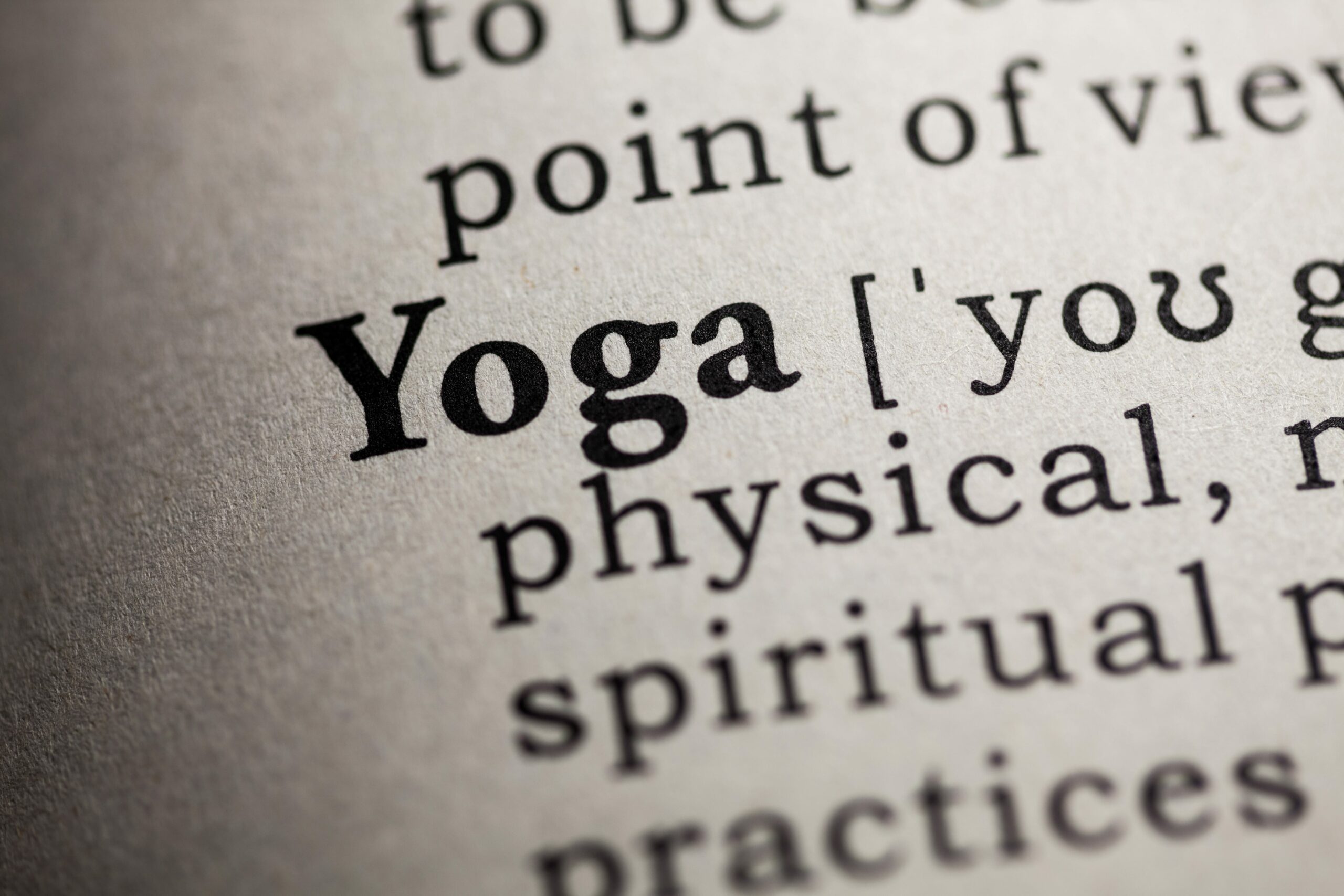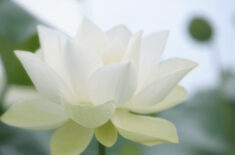It’ s helpful to know the different terms and words used in the Yoga world, especially their Sanskrit translation.
(Sanskrit is the philosophical language in Hinduism and Buddhism and one of the oldest recorded languages of the world.)
Below is a helpful dictionary including some of the most common yogic terms…
A:
- Abhinivesha: Survival instinct, fear of death, one of the five obstacles to self-realization.
- Abhyasa: Spiritual practice
- Agni: Fire; the internal fire that burns in all of us.
- Ahimsa: Non-violence, benevolence, & good intentions to self first, then others, and the world.
- Ananda: Bliss
- Anapanasati: Buddhist meditation technique involving mindful awareness of the breath.
- Aparigraha: Non-attachment, non-greed.
- Artha: Meaning, wealth
- Asanas: Yogic posture also called Yogasana designed to help balance the mind and body, the most famous pose is the lotus position.
- Asmita: Ego, egoism,
- Ashtanga: 8-limbed
- Ashtanga Yoga: The 8-limbed or 8-fold Yogic Path, also called Raja Yoga.
- Asteya: Even-exchange, non-stealing.
- Atman: The Self, individual soul, spiritual essence.
- Avidya: Ignorance.
B:
- Bhagavad Gita: (aka: Gita) “Song of God,” 700-verse ancient Sanskrit scripture found in the Hindu epic Mahabharata.
- Bhavana: To cultivate; thought: feeling: attitude
- Bhakti: love and devotion; heart intelligence
- Bhakti Yoga: The Yoga of love and devotion.
- Bija: Seed
- Brahman: The Creator of the Universe, the absolute reality, manifests force of life and creation.
- Brahmacharya: Non-excess; temperance; sense control.
- Buddhi: Intellect; discerning mental faculty.
C:
- Chakras: Literally meaning “wheel”, spiritual centers of energy (Prana) in the human system located along the spinal column. Chakras regulate the functioning of the physical, mental, and energetic bodies.
- Cit: Consciousness, universal intelligence.
- Citta: Mind-stuff
D:
- Dharana: One-pointed focus and sustained concentration. (the 6th limb of the 8-fold Yogic Path.)
- Dharma: Purpose in life; Duty, morality, ethical way of living, code of conduct, the life of responsibility and right action.
- Dhyana: Meditation, contemplation, and the process of internalizing of the mind (the 7th limb of the 8-fold Yogic Path.)
- Drishti: Focused gaze; a means of developing concentrated attention and intention.
- Dukkha: Suffering
G:
- Guna: one of the three qualities of nature (sattva (balance), rajas (activity), tamas (inertia))
- Gurudev: Teacher within each of us that can help us “remove darkness” so we may see clearly.
- Guru: “Remover of darkness”, spiritual guide, teacher who can dispel darkness.
H:
- Hatha: Ha — sun, tha — moon
- Hatha Yoga: physical aspect of Yoga practice including postures (asanas), breathwork (pranayama), seals (mudras), locks (bandhas), and cleansing practices (kriyas)
- Himsa: violence; injury or pain
I:
- Indra: King of the gods; ruling power of nature
- Indriya: Sense organs
- Ishvara: supreme cosmic soul; God
- Ishvara Pranidhana: self-surrender, dedication, and devotion to a cause greater than one’s self; devotion to the divine.
J:
- Japa: Recitation, repetition, continuous chanting of a sacred sound or Mantra practiced verbally or in mind.
- Jaya: Victory, mastery
- Jivanmukta: Liberated soul
- Jnana: real wisdom, understanding, the power of intellect, knowledge of the Self often derived from meditation and walking the 8-fold path.
- Jnana Yoga: The Yoga of Self Inquiry
K:
- Kaivalya: The state of total awareness and liberation.
- Karma: Literally action; includes the law of cause and effect, the consequence of an action, performing positive actions results in positive results.
- Karma Yoga: The Yoga of Inspired Action & Selfless Service without attachment to results.
- Karuna: Compassion, mercy
- Klesha: Obstacle or obstruction
- Kriya: action, Practice; (Hatha Yoga) cleansing practice.
- Kriya Yoga: According to Patanjali – the three primary steps in Yoga (tapas (self-discipline), svadhyaya (self-study), and ishavara pranidhana (surrender))
- Kosha: One of five sheaths enclosing the Atman, the five koshas are: Physical, Energy, Mental, Wisdom and Bliss.
- Kundalini: The primordial cosmic energy and consciousness latent in every being that is located at the base of the spine and symbolized by a fire snake lying coiled.
M:
- Maharishi: A great sage, a great soul.
- Maitri: friendliness; good disposition
- Manas: the desiring faculty of mental activity.
- Mandukya Upanishad: Upanishadic treatise of OM, considered the highest jewel of all of the Upanishads.
- Mantra: “That makes the mind steady,” vibrational sounds used in meditation to quiet the mind or acquire mental balance.
- Maya: Illusion
- Moksha: Freedom, salvation, liberation.
- Mudra: A sealing posture that distributes cosmic energy through the mind and body, this can be a whole-body gesture or a hand gesture.
- Mukti: Liberation, freedom
N:
- Nadi: Energy channels in the body through which Prana flow, nadi also refers to the veins and arteries of the material body.
- Nidra: Sleep.
- Nirodha: Cessation, restraint.
- Nirvana: Buddhist state of liberation from suffering.
- Niyama: Personal observances; the 2nd limb of the 8-fold Yogic Path; contains five elements (cleanliness, appreciation, self-discipline, self-study, and surrender.)
O:
- Ojas: Spiritual energy, vigor.
- Om: Or Aum, a universal mantra, is a sacred syllable which symbolizes Brahman; cosmic sound vibration.
P:
- Padma: Lotus flower symbolizing the emergence of light from the darkness.
- Padmasana: Lotus pose is the most renowned of all Asanas
- Pancha Indriya: The five senses.
- Patanjali: The Yogi and Sage who compiled and organized the true practice of yoga into the system of the Yoga Sutras; founder of the 8-fold Yogic Path; considered the “Father of Yoga.”
- Pingala: A nadi (energetic channel in the body) running on the right side of the spine through which prana runs.
- Prana: Vital energy, soul of the universe, the energy that animates everything, the force sustains life in a physical body.
- Pranayama: The rhythmic control of the breath, method of controlling prana through inhalation, retention, exhalation; 4th limb of the 8-limbed Yogic Path.
- Pranidhana: Total dedication.
- Pratipaksa Bhavana: The practice of substituting opposite thought-forms in the mind.
- Pratyahara: The practice of drawing the senses away from the external world and towards the internal world; the 5th of the 8-limbed Yogic Path.
- Puja: Offering; Devotional worship.
R:
- Raja: King
- Raja Yoga: “Royal Yoga,” the Yoga of Mind & Emotions; the Yoga of Introspection & Contemplation
- Rajas: Activity, restlessness (one of the three Gunas)
- Rama: Bija (seed) mantra, another name for the divine.
- Rishi: A great sage, one who contemplates the reality of life.
S:
- Sadhana: Spiritual practice, a spiritual discipline, a means of accomplishing something.
- Sahasrara (chakra): The thousand petal lotus; subtle energy center located at the crown of the head where consciousness and energy go into the higher states of Samadhi (transcendence).
- Sakshi: Witness.
- Sama: Balanced state of mind, serenity.
- Samadhi: State of transcendence – transcending the lower self and reaching a deeper connection to the higher self and mind; State of equanimity.
- Samskara: Mental impressions; the scope of experiences we collect throughout our life journey; the infinite flow of feelings, actions, ideas, choices, and emotions of life.
- Samvit: Consciousness, the full energy of knowledge.
- Sanskrit: The philosophical language in Hinduism and Buddhism and one of the oldest recorded languages of the world.
- Santosha: Appreciation and contentment.
- Sannyasa: Renunciation
- Sat: Truth, existence.
- Satchitananda: The Consciousness of Joy and Bliss.
- Sattva: Purity, reality and truthfulness.
- Satya: Truthfulness.
- Saucha: Cleanliness; Purity.
- Savasana: Corpse pose; the main pose used in Yoga Nidra practice.
- Shakti: feminine power; energy; the Divine Mother.
- Shanti: Peace
- Shiva: Universal god of destruction, “the destroyer.”
- Smrti: Memory
- Sukha: Happiness
- Sutra: Thread; suture. Aphorism.
- Svadhyaya: Self-study.
- Swami: Literally: “one with the self”, title given to a monk or spiritual master.
T:
- Tamas: inertia (one of the three Gunas)
- Tantra Yoga: The practice of using yantra and mantra to experience the union of the masculine (Shiva) and feminine (Shakti) and positive and negative forces within the individual.
- Tapas: Self-discipline through the challenge of fire; the process of burning away impurities; accepting pain as a teacher.
- Trimurti: the Hindhu three-fold diety consisting of the Creator (Brahma), Maintainer (Vishnu), Destroyer (Shiva.)
U:
- Upanishads: Final portion of the Vedas’ Vedanta (non-dualistic) philosophy; the ancient scriptures of Hindu philosophy containing the doctrines of Yoga, meditation and karma.
V:
- Vairagyam: Detachment; non-attachment.
- Vibhuti: Blessing; power.
- Vidya: Knowledge; learning.
- Vinyasa: The fluid movement of a sequence of asanas (postures).
- Viparyaya: Misconception.
- Virya: Vital energy; strength; semen
- Vishnu: The “Maintainer,” diety that forms part of the Trimurti.
- Viveka: Discrimination of the real from the unreal.
Y:
- Yama: Abstinence; self-regulating behaviors that form the 1st limb of the 8-limbed Yogic Path (includes: benevolence, truthfulness, even-exchange, non-attachment, non-excess.)
- Yantra: A sacred geometrical figure representing a particular aspect of the Divine.
- Yoga: “Union”; Union of the Self with all its parts; Union of the Self with the Absolute; any path that allows such a union to form; the stilling of the ripples (fluctuations) of the mind.
- Yoga Nidra: The practice of Yogic Sleep; Uses the principles of asana, pranayama, pratyahara, dharana, and dhyana to recondition the mind, and create Yoga in the body.
- Yogi: Someone who follows the path of Yoga. A female yogi is called a yogini.













